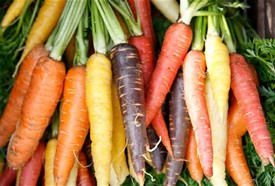
I was surprised to learn on the USDA website that the earliest references to carrots were to purple and yellow types found in Afghanistan between 900 AD and 1000 AD. By the 1300s, these varieties had made their way to Europe and China. And by the 1700s, white carrots were being grown in Europe. Orange carrots finally made an appearance around this time.
Oil paintings from the Netherlands during this period depict orange and white carrots in still lifes of kitchen scenes. I'll be looking for them on my next museum visit.
Today Turkey, India and China grow purple, yellow and red carrots, while in the Middle East people prefer mostly purple and yellow types. White carrots are largely used for livestock feed in Europe, with orange carrots now the norm in most of the rest of the world.
Many of us have been told to “eat your carrots” at least once, and it seems to be good advice.
Carrots provide 30 percent of the vitamin A in the American diet, and they are a low-calorie source of fiber and potassium. According to the USDA, Americans eat an average of 11 pounds per year, so some of us must be paying attention.
With such colorful choices, knowing the subtle differences between them will add to your carrot sophistication.
White carrots like ‘Snow White contribute valuable fiber, but their lack of color signals fewer micronutrients. The ubiquitous orange carrot provides beta and alpha carotenes that protect our eyes and immune systems.
The striking ‘Cosmic Purple' carrot with its heart of gold provides the nutritional benefit of anthocyanin. According to the USDA, this micronutrient helps prevent heart disease and stroke with an antioxidant effect that protects against harmful free radicals.
Sunny yellow carrots like ‘Solar Yellow' and ‘Yellow Sun' boast xanthophylls, the same pigments responsible for the color in fall leaves. These pigments are beneficial in the fight against macular degeneration and cancer prevention. Red carrots like ‘Atomic Red' contain lycopene, the same pigment that makes tomatoes red.
Carrots are a $300 million crop in the U.S., with half of all production in California. Clearly we can grow carrots in this state.
According to the USDA, it takes just over one square yard to produce enough carotene-rich carrots to supply all the vitamin A an adult needs for a year. That's a good reason to sow some carrots.
Find a sunny spot in your garden for carrots, and prepare the soil well. Most carrot varieties are long and straight;if you are digging beds, aim for at least 18 inches of loose soil. Round carrots are a good choice if your beds can't be deep.
Some carrot varieties do better in clay soil than others, but all prefer a soil pH of 5.5 to 6.5. Carrot seed germinates best in warm soil. Carrots can tolerate some light shade, which means you can interplant with other crops. Read the seed packet for more detail.
Scatter carrot seed on the surface of the prepared bed and rake it in gently. Some seed packets recommend surface sowing with no soil cover, while others recommend covering the tiny seeds with no more than a quarter-inch of soil. Some gardeners prefer to grow in rows, sowing a few seeds every inch with rows 16 to 18 inches apart; others prefer to broadcast seeds in blocks.
Toss a few radish seeds in the same row or block to see green pop up a little faster. Radishes can help mark the row for slower-germinating carrots. Keep the bed moist until the carrot seeds germinate.
Thinning carrots is essential. Most seed packets recommend sowing more seeds than you need so you have adequate germination, but the more seeds that sprout, the fiercer the competition. As difficult as it may be to pull up and toss seedlings, thin to seed packet recommendations for best results.
Split carrots? Uneven watering. Twisted? Heavy soil.Hairy and rooty? Too much nitrogen.
The other tough lesson about carrots is, don't pull them up to see if they are growing. But if you accidentally do so, toss the tiny carrots in your salad. They are good for you, too.
Garden Tour: The UC Master Gardeners of Napa County invite you to attend their sixth garden tour, “Down the Garden Path,” on Sunday, September 13. On this self-guided educational tour, you will see seven gardens owned by Master Gardeners in and around the City of Napa. These gardens illustrate how Napa County Master Gardeners use University of California research-based horticultural information to develop and maintain their own gardens. Tickets: $30 advance / $35 day of event. Purchase tickets here: http://bit.ly/1fqLJZe. Or you can purchase tickets at the Master Gardener office (address below). For more information, call 707-253-4143.
Workshop: Napa County Master Gardeners will hold a workshop on “Food Preserving” on Saturday, August 29, from 9 a.m. to noon, at the University of California Cooperative Extension office, 1710 Soscol Avenue, Napa. Conserving your garden's bounty and knowing exactly what's in your food are just two reasons to preserve food at home. If done correctly,canning is a safe way to process fruits and vegetables. Learn the basics of water-bath canning, pressure canning and other easy preservation techniques. Online (credit card only)Mail-in registration (cash or check only).
Master Gardeners are volunteers who help the University of California reach the gardening public with home gardening information. Napa County Master Gardeners ( http://ucanr.org/ucmgnapa/) are available to answer gardening questions in person or by phone, Monday, Wednesday and Friday, 9 a.m. to Noon, at the U. C. Cooperative Extension office, 1710 Soscol Avenue, Suite 4, Napa, 707-253-4143, or from outside City of Napa toll-free at 877-279-3065. Or e-mail your garden questions by following the guidelines on our web site. Click on Napa, then on Have Garden Questions? Find us on Facebook under UC Master Gardeners of Napa County.